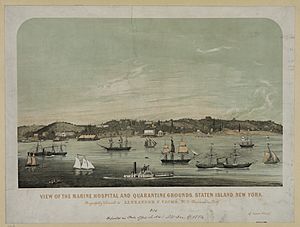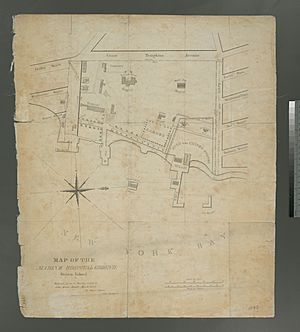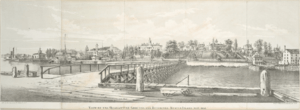Staten Island Quarantine War facts for kids
The Staten Island Quarantine War was a big event that happened on September 1 and 2, 1858. It was a series of attacks on the New York Marine Hospital, which was located on Staten Island. This hospital was known as "the Quarantine" because it was a place where people who might be sick were kept separate from others. At the time, it was the biggest facility of its kind in the United States.
Most of the people who attacked the hospital were residents of Staten Island. Back then, Staten Island was not yet part of New York City. These attacks happened because people on the island had been unhappy for a long time about the quarantine facilities being so close to their homes. During the attacks, people set a huge fire that completely destroyed the hospital buildings. Later, the people who led the attack went to court. They successfully argued that they had destroyed the Quarantine to protect themselves and their community. No one died directly because of these attacks. However, this event is an important historical example of how quarantines were used in the past.
Contents
Why the War Started
For several years, from 1795 to 1798, a disease called yellow fever caused many deaths in New York City. To stop the spread, the city leaders passed a quarantine law in 1799. This law helped create the New York Marine Hospital. The first patients arrived there in 1800. Richard Bayley, who was the first health officer for the port, even died from yellow fever while caring for patients at the hospital in 1801.
The Quarantine hospital was very large and could hold up to 1,500 patients. In the 1840s, it treated more than 8,000 patients every year. By the 1850s, a strict system was in place. When ships arrived, health officials would check them. If anyone showed signs of sickness, all passengers were taken to the Quarantine. First-class passengers stayed in a building called St. Nicholas Hospital, while others stayed in simpler wooden shanties.
The Hospital's Location
The Quarantine was built on a large piece of land in an area that used to be called Castleton. It overlooked Upper New York Bay. Today, this area is near St. George and Tompkinsville. The land is now home to the St. George Coast Guard Station and the National Lighthouse Museum.
The Quarantine facility had many buildings, including:
- St. Nicholas Hospital, which was the main building.
- The Smallpox Hospital, which had six separate rooms for patients.
- The Female Hospital, a two-story building for women.
- Office buildings for staff, harbor inspectors, and doctors' homes.
- Eight wooden shanties for housing patients.
A six-foot-high brick wall surrounded the entire hospital area.
Growing Unhappiness
People living on Staten Island were unhappy about the Quarantine from the very beginning. You could say that the "quarantine war" was a long-running disagreement that lasted for decades. Landowners were against the city buying the land for the hospital. They also complained that the Quarantine made their property less valuable. One developer said in 1849 that the hospital was "very injurious" to selling property.
Staten Islanders also believed that the hospital was causing local outbreaks of infectious diseases. On top of that, there was growing tension between the hospital workers and the local residents throughout the 1850s.
Trying to Move the Hospital
In 1857, officials from New York City tried to calm the anger by moving the hospital to a more distant spot on Staten Island called Seguine Point. However, before the new hospital could be finished, people from the town of Westfield set fire to the construction site.
One person involved in that attack wrote an anonymous letter to The New York Times. They signed it "An Oysterman." The letter warned that if construction started again, "every urchin who can rub a match will aid in producing a general conflagration." This meant that even children would help burn down any new buildings. Another person wrote to The New York Times saying that people would fight against a new hospital at Seguine Point, even if it cost "thousands of lives."
In April 1858, more fires destroyed the remaining buildings at Seguine Point. New York State and City officials offered a reward of $3,000 for information about the people responsible. But only one person was arrested.
The Attacks of September 1 and 2
Local residents acted quickly after a decision was made by the Castleton Board of Health. As it got dark, two large groups attacked the Quarantine. One group broke down the main gate. The other group climbed over the wall on the opposite side. The attackers made sure all patients were safely out of the buildings. Then, they systematically used mattresses and hay to set every building on fire.
The New York Times reported that the huge fire lit up the entire bay and the east side of Staten Island. When hospital employees or firefighters tried to put out the fires, they were met with violence. One worker was even shot. Ray Tompkins, who was a leader of the attackers and a grandson of a former governor, convinced the crowd not to physically harm the medical staff. Tompkins also made a deal with the hospital staff. He said they would leave the Female Hospital standing if the staff released any attackers they had caught earlier. The attackers also knocked down large parts of the wall around the Quarantine. Two men died that night. One died from yellow fever, and one hospital staff member was killed by a co-worker. New York City officials were slow to respond. This was partly because sending police into a quarantine zone was risky, and violence was likely.
The next day, a flyer was posted all over Tompkinsville. It announced:
A meeting of the Citizens of Richmond County, will be held at Nautilus Hall, Tompkinsville, this evening, September 2 at 7 1-2 o'clock [sic], for the purpose of making arrangements to celebrate the burning of the shanties and hospitals at the Quarantine ground last evening, and to transact such business as may come before the meeting. September 2nd, 1858.
Several hundred people attended this meeting. Afterward, they went to the Quarantine. The crowd then burned down the Female Hospital and the piers.
What We Learn From This
Experts who study medical ethics and public health often say that quarantines, which take away people's freedom, are rarely fair or effective. The Quarantine War showed how strict quarantine rules can make communities turn against not only sick people but also against the health professionals trying to help them.
Images for kids








